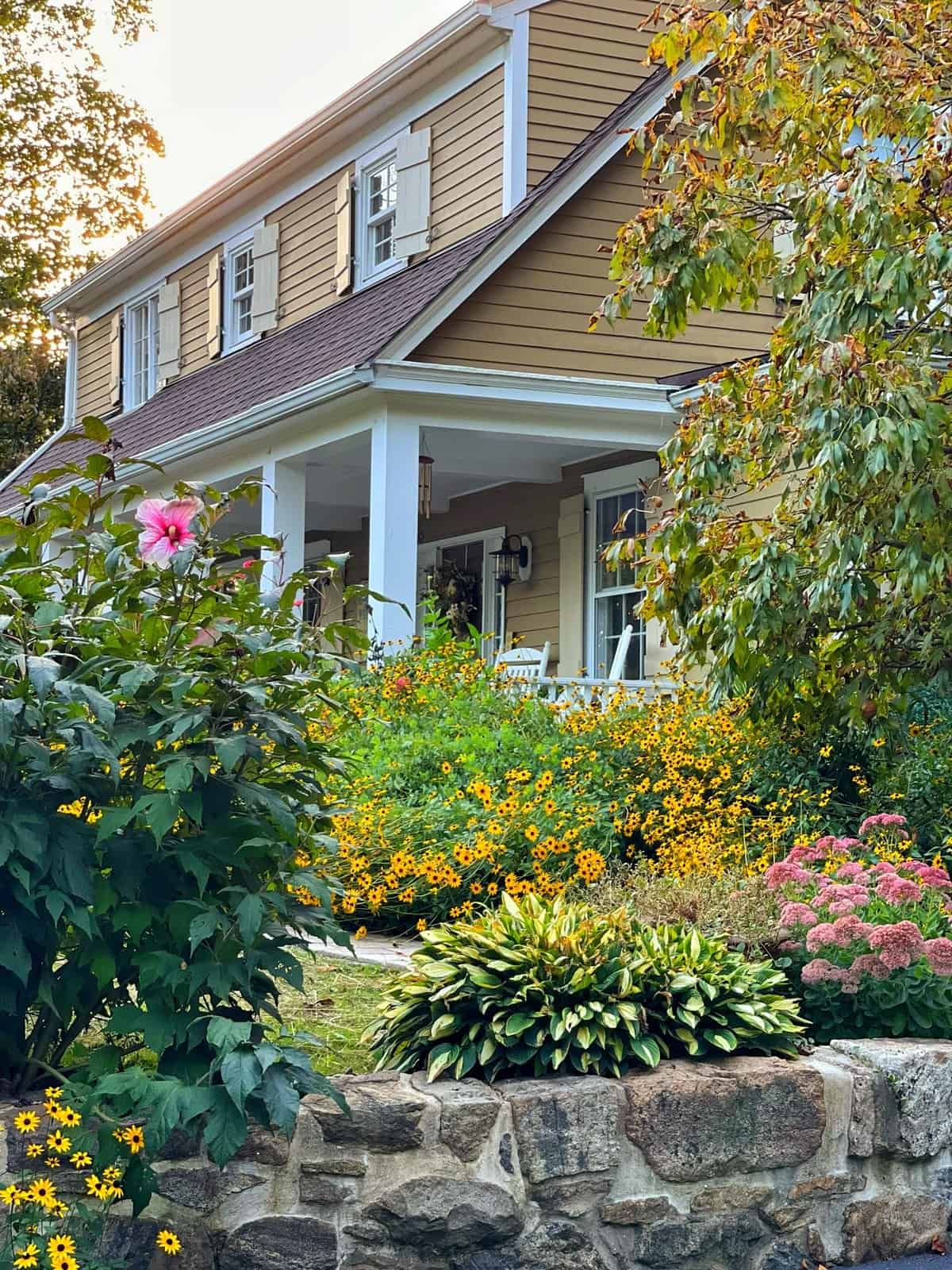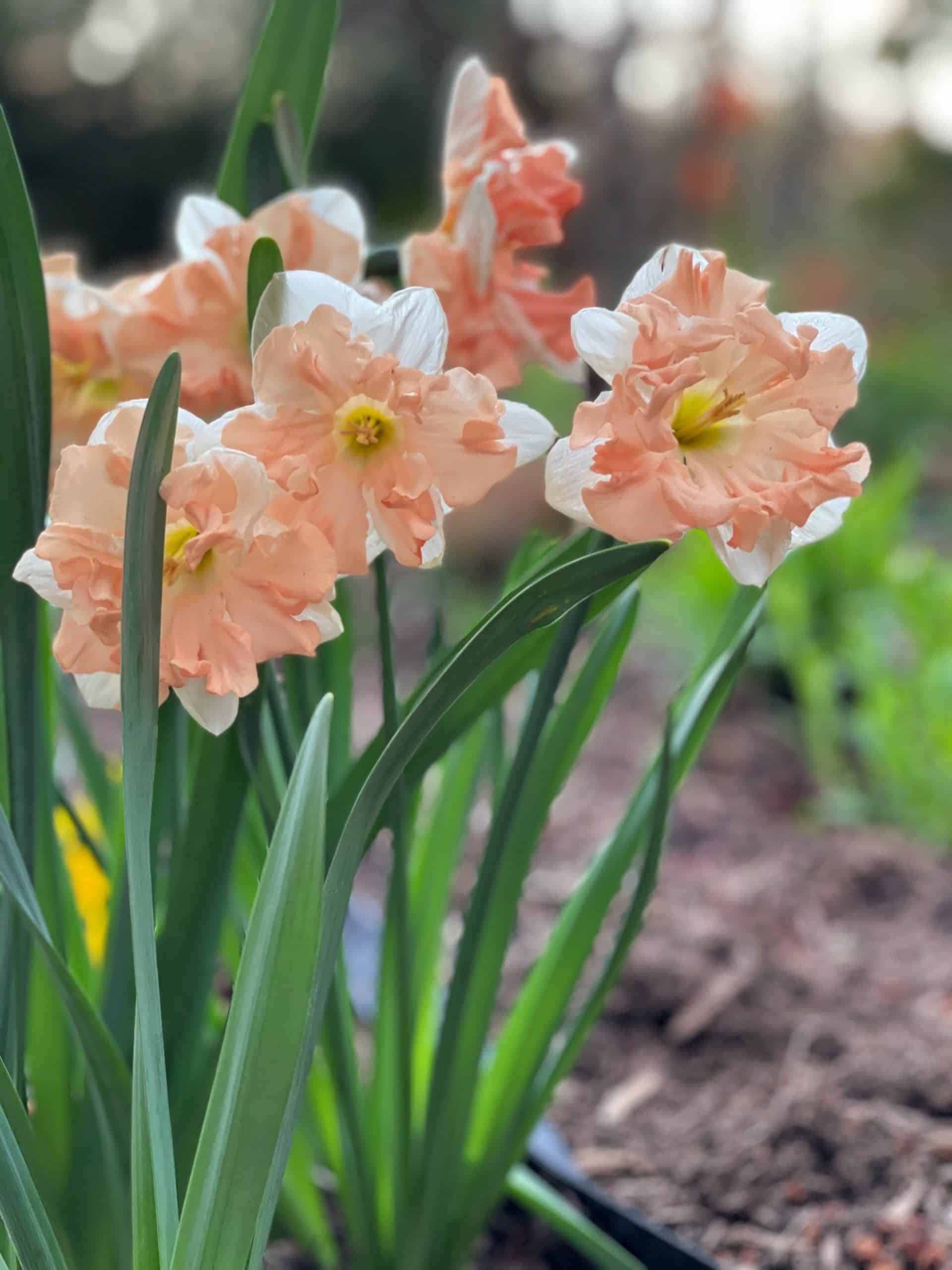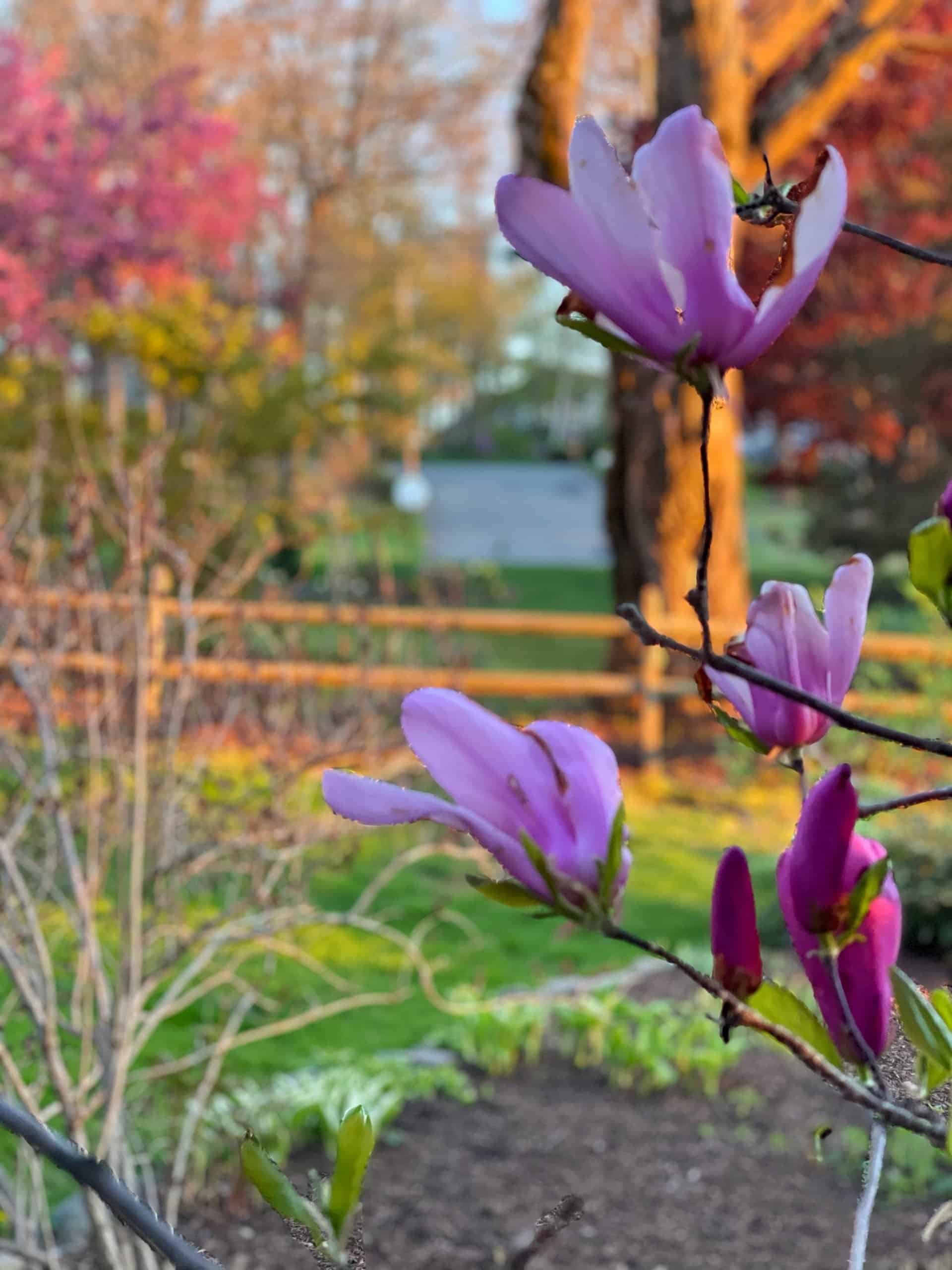Tired of deer destroying your garden? Learn how to keep deer out of your garden with this comprehensive guide. Discover effective strategies for deer control.
You’ve poured your heart and soul into your garden, nurturing tender seedlings into vibrant plants, growing flowers, and dreaming of a bountiful harvest. But then, the unthinkable happens. You wake up to find your once-flourishing oasis ravaged, leaves nibbled to stems, flowers decapitated, and your hard work seemingly destroyed overnight.
The culprit?
Those adorable yet insatiable garden bandits: deer. It’s a disheartening experience that many gardeners including myself face, but don’t despair! This guide is your lifeline to reclaiming your garden and protecting your precious plants from those persistent deer.
We’ll chat about proven strategies, from effective repellents and fencing solutions to clever planting choices and expert tips, so you can finally enjoy the fruits (and vegetables!) of your labor.
(Posts on stacyling.com may contain affiliate links. Click HERE for full disclosure.)

Understanding Deer Behavior and Habits: The Key to Protecting Your Garden
Before we dive into the nitty-gritty of deer-proofing, it’s crucial to understand why these graceful creatures wreak havoc on our gardens in the first place. By understanding their motivations and patterns, we can better anticipate their actions and devise effective strategies to protect our plants.
Why Deer Target Gardens
Deer are primarily herbivores, meaning they feed on plants. While their natural diet consists of leaves, twigs, and fruits from forests and fields, they’re opportunistic feeders and won’t hesitate to explore gardens that offer an enticing array of tasty treats.
Some of the main reasons why deer target gardens include:
- Abundance of food: Gardens often contain nutrient-rich plants that are more palatable and easier to access than their wild counterparts.
- Limited natural food sources: During certain seasons or in areas with depleted natural resources, deer may rely on gardens to supplement their diet.
- Curiosity: Deer are naturally curious animals and may wander into gardens to investigate new smells and sights.
- Lack of predators: In suburban areas, deer may feel safer venturing into gardens due to the absence of natural predators.

Peak Deer Activity Times
Understanding when deer are most active can help you tailor your protective measures. Generally, deer are crepuscular, meaning they are most active during dawn and dusk. However, they may also be active during the night or even during the day, especially in areas with less human activity.
Common Plants Deer Love (and Hate)
Deer have preferences when it comes to their plant-based diet. Some plants are like candy to them, while others are downright repulsive. Knowing which plants deer find most appealing can help you make informed planting decisions to minimize damage.
Plants deer typically love:
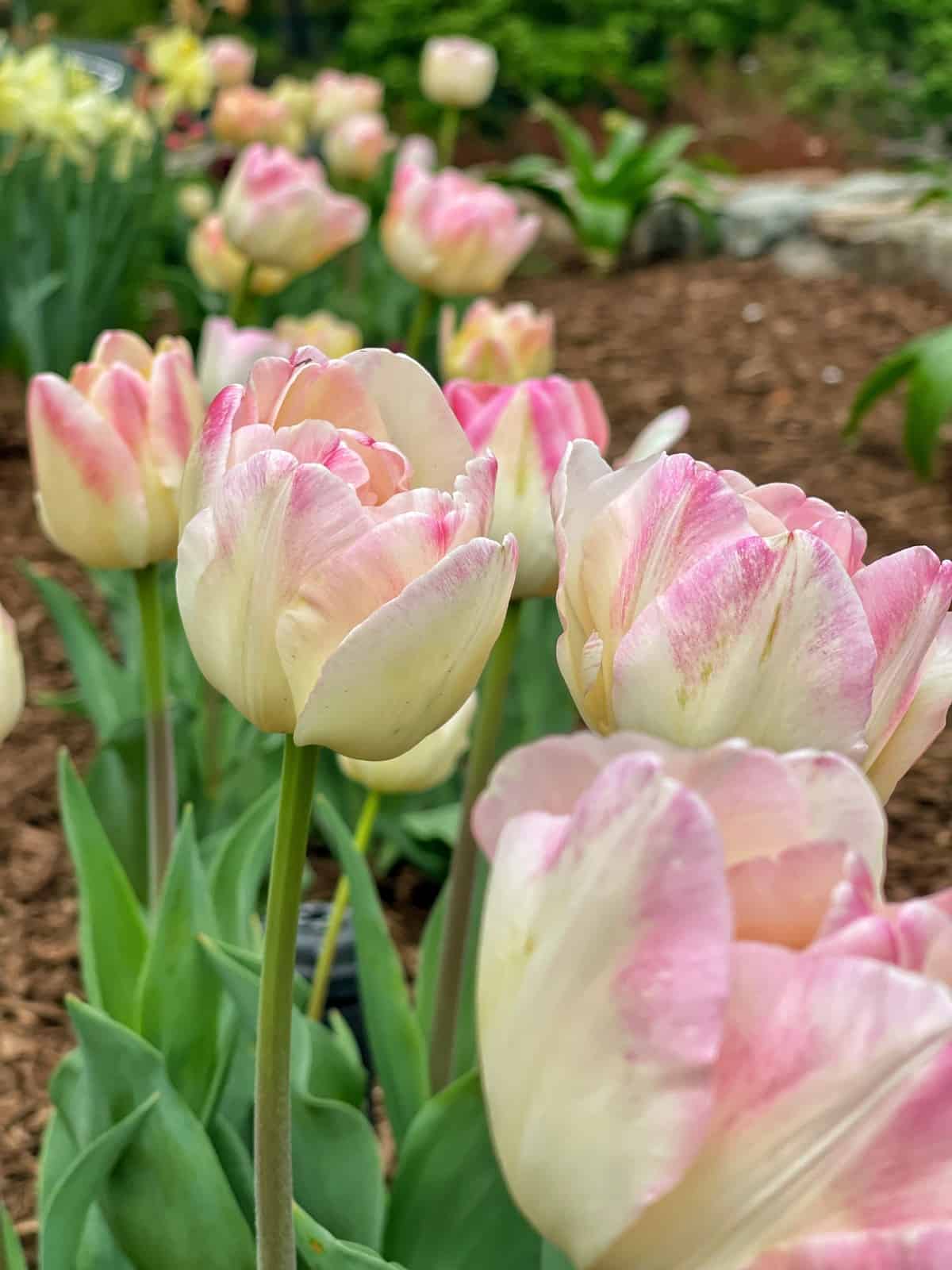
I shared a list of beautiful cottage garden flowers that deer do not eat, but here is a quick list of some favorite plants deer generally dislike:
Keep in mind that deer preferences can vary depending on the season, availability of food, and individual deer. By understanding these key aspects of deer behavior and habits, you’ll be better equipped to outsmart those hungry herbivores and protect your garden from their insatiable appetites.

Proven Deer-Proofing Strategies That Work
Now that we understand why deer target gardens and their behavioral patterns, it’s time to fight back! With the gardens bursting from the ground, deer are coming out in full force ready to eat my garden plants. And they’ll continue to drop by straight through fall if I don’t take measures to deter them.
Since I’m often asked how to keep deer from eating plants and flowers in the garden, this post is going to cover everything that I do plus some things that don’t work (for me anyway!). While no method is foolproof, there are a few precautions that can be taken to minimize deer damage. I implement a few strategies that work well for me and have given the same advice to family, friends, and clients who have had similar success.
Keep in mind that what works for me may not work for you, but a combination of these tips and tricks will help keep deer from eating garden plants. So it can take some doing on your part to figure out what works best in your garden.
Here’s a comprehensive arsenal of proven strategies to protect your garden from deer damage.
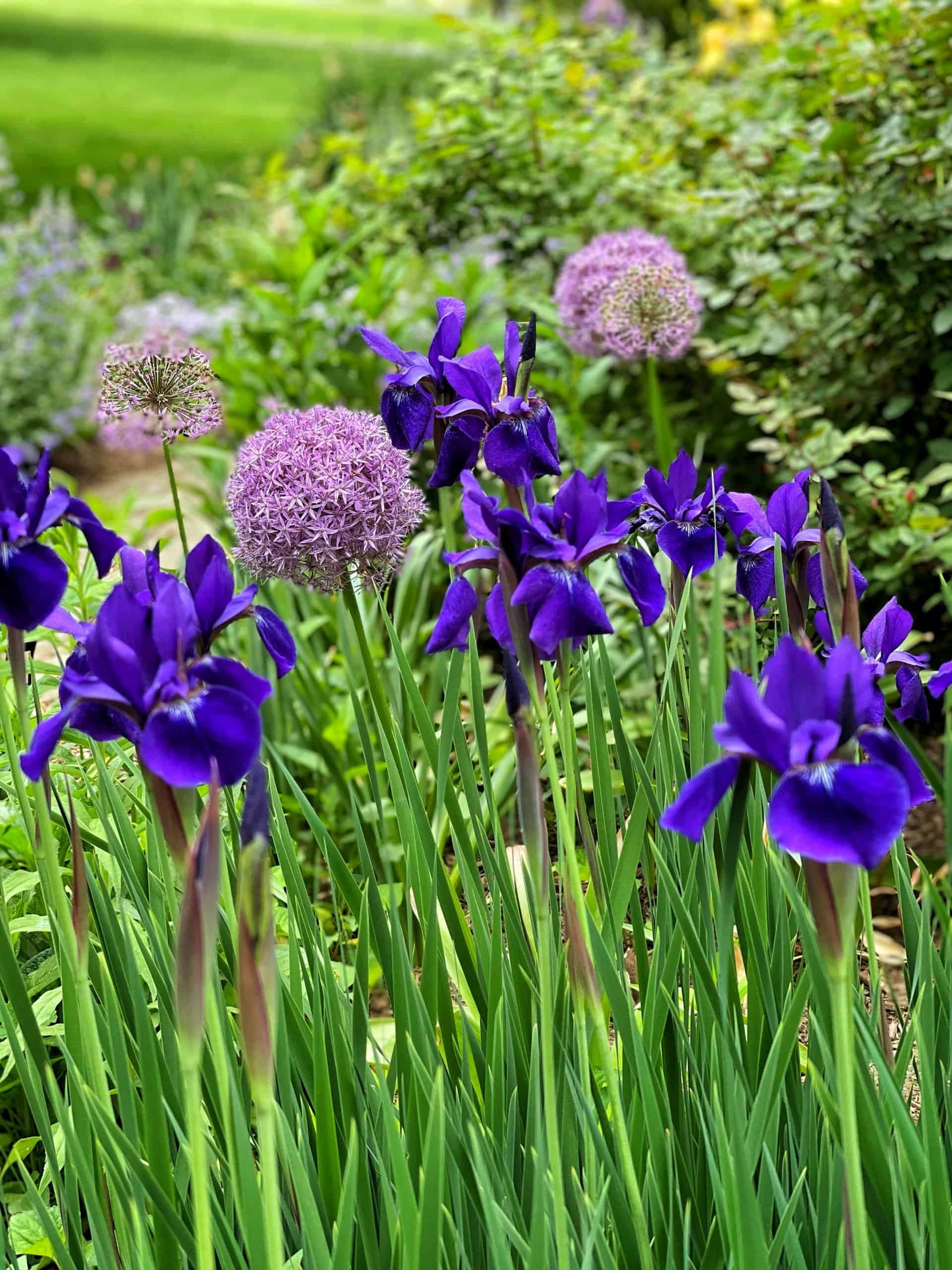
Strategic Planting for Deer Deterrence: Outsmarting Their Palate
One of the most effective strategies you can do is plant smart. Learn what garden plants deer do not eat and focus on deer-resistant plants. While no plant is completely deer-proof, some are less appealing to their taste buds. By choosing plants that deer dislike and implementing strategic planting techniques, you can significantly reduce their interest in your garden.
The best starting point is the Rutgers Cooperative Extension list that grades plants by deer-resistance. I refer to this list all the time when I am designing and planting a garden.
There are many beautiful plant options that deer will avoid or rarely damage. So if deer are a problem in your neighborhood, start with this rated list because it is gold!
Quick Tip: Deer dislike sharp, prickly, rough, heavily scented plantings. They love glossy, soft green leaves and flowers (tulips, hostas, pansies, or mums anyone?).
Top Deer-Resistant Plants in My Gardens
While this is not an exhaustive list of deer-resistant plantings in my beds, I have had luck with the following:
- Daffodils
- Crocus
- Hellebores
- Bearded Iris
- Catmint
- Salvia
- Russian sage
- Bee balm
- Herbs
- Lavender
- Snapdragons
- Peonies
- Poppies
- Anything from the onion family
- Ornamental grasses
- Prickly evergreens like juniper.
It is also worth noting that deer tend to follow the same path when they forage for food. Once they learn they are not fans of plants in your garden, they will seek a different path. This is why deer repellents are helpful. Because they teach deer that they don’t like what’s available so they move on. To read my take on the best deer repellents to use, check out this article
This does not mean they won’t ever return, but rather, may temporarily find better options in another location. Therefore, it is best to keep your plantings as unpalatable as possible. And NEVER get complacent with deer repelling strategies because as soon as you get a little lazy, they’ll eat your garden. Been there done that – be diligent!

Companion Planting for a Deer-Proof Garden
Companion planting involves interplanting different species to deter pests or improve plant health. Certain plants, like garlic, chives, and onions, emit strong odors that deer dislike, making them excellent companions for more vulnerable plants.
While I typically lean towards deer-resistant plantings, I also grow things that require more protection. When planting higher-risk plants, like hostas for example, I group them together with plants that are less risky like bleeding hearts or brunnera.
When I design the beds, I’ll use less risky plants in the front of the border and plant higher-risk plants towards the back so there’s almost a barrier. Thus, planting both high and low-risk plants together helps protect plants that are more susceptible to deer damage.
By combining these proven strategies, you can create a multi-layered defense system that will deter even the most persistent deer and safeguard your garden from their insatiable appetite.
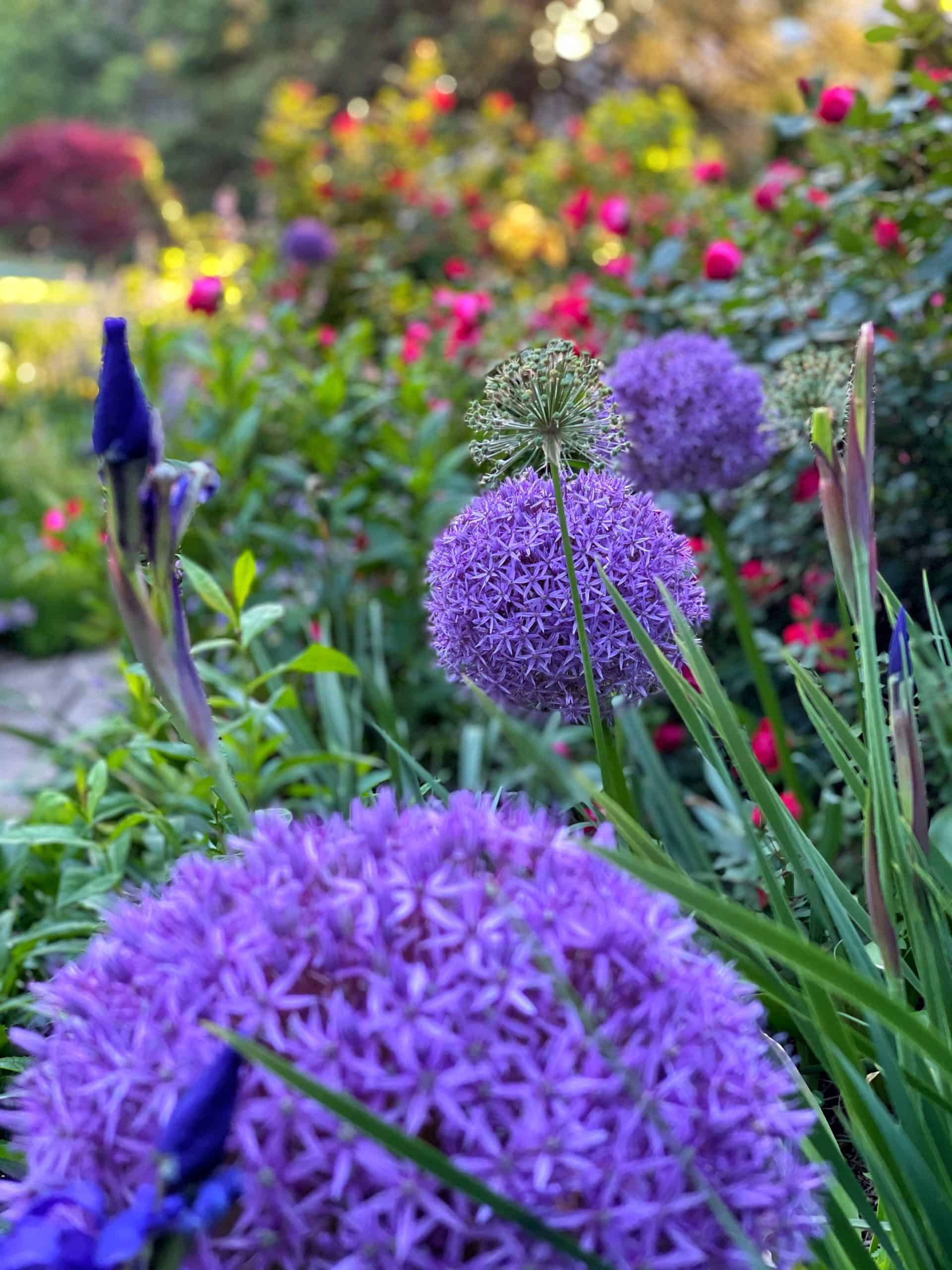
Effective Deer Repellents: A Sensory Assault to Keep Deer From Eating Plants
Deer rely heavily on their sense of smell and taste to navigate their environment and choose their food. Deer repellents exploit these senses by creating unpleasant odors or tastes that deter deer from feasting on your plants.
Types of Repellents
- Commercial Repellents: These come in various forms, including sprays, granules, and concentrates. They often contain ingredients like putrescent egg solids, dried blood, or garlic oil, which deer find repulsive.
- Homemade Repellents: Many household items, like eggs, hot peppers, soap, and human hair, can be combined to create effective deer deterrents.
- Natural Repellents: Certain plants, like lavender, rosemary, and mint, have strong scents that deer dislike. Planting these around your garden can act as a natural barrier.
How to Use Deer Repellent More Effectively
In general, here’s what you should when applying deer repellent to your garden plants.
- Apply repellents regularly, especially after rain or watering.
- Reapply more frequently during peak deer activity times (dawn and dusk).
- Rotate different types of repellents to prevent deer from becoming accustomed to a single scent or taste.
- Focus on vulnerable plants and areas where deer frequently enter your garden.
While the bottle has application directions, I am more aggressive with the spray schedule for higher-risk plants. I start spraying high-risk plants when they emerge from the ground, then again about one to two weeks later, depending on the growth. And then spray every three to four weeks after. This method has worked for me for many years. And if you try it, I hope it works for you too.
In my former garden, I added a granular around the perimeter of my property and that seemed to keep the deer away as well. For a time, I also used this granular deer repellent in conjunction with the spray repellent and found that it also worked really well.
Watch this video to learn more about it!
What Deer Repellents Actually Work? My Tried-and-True Picks
In addition to following the deer-resistant plant list, I spray high-risk plants with deer repellent and have found it to be very effective when you are consistent.
Lately I’ve been using this deer repellent that is systemic and not just topical only. It is stinks badly and initially stains your plants, but it is very effective and helps protect plants from other types of critters like rabbits and groundhogs too.
But I’ve also been using this deer repellent for several years with great success. It smells minty and the nozzle does not clog. Plus it works really well. So it continues to be a must-have deer repellent in my gardens today.
What do other experts say?
Many experts recommend switching spray products so deer do not work through a particular repellent. This method did not work for me because other deer-repellent products clogged and prevented me from using the product without a struggle.
That said, try the ‘switch it up method’ if one repellent does not work for you. Or try using both the repellent and granular method I mentioned above. Sometimes, I’ll spray a few plants in a garden but not the others around it if they are less susceptible to damage.

For example, deer sometimes browse on my sedum autumn joy that is in the front row of one of the beds. So I spray them a few times from early spring through fall which seems to protect them.
They have not bothered my roses, variegated dogwood, or Joe Pye weed that I grew in the same bed and did not spray with repellent. I only spray a few plants in the front row and that strategy seems to work for me. If I notice other plants getting damaged, I will spray them too.
At the end of the day, you have to test things out and do what works for you – every garden and gardener is different. You’ll learn through trial and error.

Deer Fencing: The Ultimate Barrier Against Hungry Invaders
While repellents offer a first line of defense, a physical barrier like a deer fence can be the most effective way to deter those persistent garden munchers. A well-constructed fence acts as a clear boundary, discouraging deer from even attempting to enter your precious garden oasis.
Best Deer Fencing Options for Your Garden
Choosing the right fence depends on your budget, aesthetic preferences, and the size of your garden. Here are the most popular and effective deer fencing options:
- Woven Wire Deer Fencing: This tall (8 feet or higher) and sturdy option is a classic choice for deer exclusion. The small mesh openings prevent deer from squeezing through or reaching over.
- Electric Deer Fencing: A more discreet and cost-effective solution, electric fences deliver a mild, yet memorable shock that teaches deer to stay away. While effective, they require regular maintenance and may not be suitable for all situations.
- Polypropylene Deer Fencing: Lightweight, durable, and relatively easy to install, polypropylene mesh fencing is a popular choice for home gardeners. Its high visibility helps deter deer before they attempt to jump.

Deer Fence Installation Tips: Building a Fortress for Your Plants
Proper installation is key to ensuring the effectiveness of your deer fence. Here are some essential tips to keep in mind:
- Height Matters: Deer are skilled jumpers, so make sure your fence is at least 8 feet tall, or even taller if you have particularly athletic deer in your area.
- Bury the Base: To prevent deer from burrowing under, bury the bottom of the fence at least 12 inches deep.
- Secure the Structure: Use sturdy posts (metal or wood) and ensure the fence is tightly secured to prevent sagging or gaps that deer can exploit.
- Regular Maintenance: Inspect your fence regularly for damage or loose areas and make repairs promptly. Keep the fence line clear of vegetation that could provide deer with footholds for jumping.
By investing in a quality deer fence and following proper installation practices, you can create a formidable barrier that will keep those hungry herbivores at bay and give your plants the protection they deserve.

How Do You Build a Deer-Proof Garden?
They are known to jump 6′ fences, so an 8′ fence or higher would be ideal (check your local zoning laws before installing). If you want a lower fence, you could also install a double fence about a foot apart. I’ve also seen gardeners install tall polls or wood stakes and run fishing line to get the height out of lower fencing.
Deer lack depth perception and generally will not jump a fence if they see another fence behind it because they can’t judge the distance between the two.

Case Study: Deer-Proof Garden Using Double Fencing
Before making the raised garden beds, my vegetable garden was enclosed with smaller fencing within a few feet of our split rail fence. Deer never jumped that fence or went inside the garden. As an aside, deer did not bother with my new raised garden beds either.
Was it the granular repellent method I ran around the perimeter of my property or did they lack the depth perception to jump in? Either way, it worked. I saw deer in the backyard but they never bothered those raised beds.
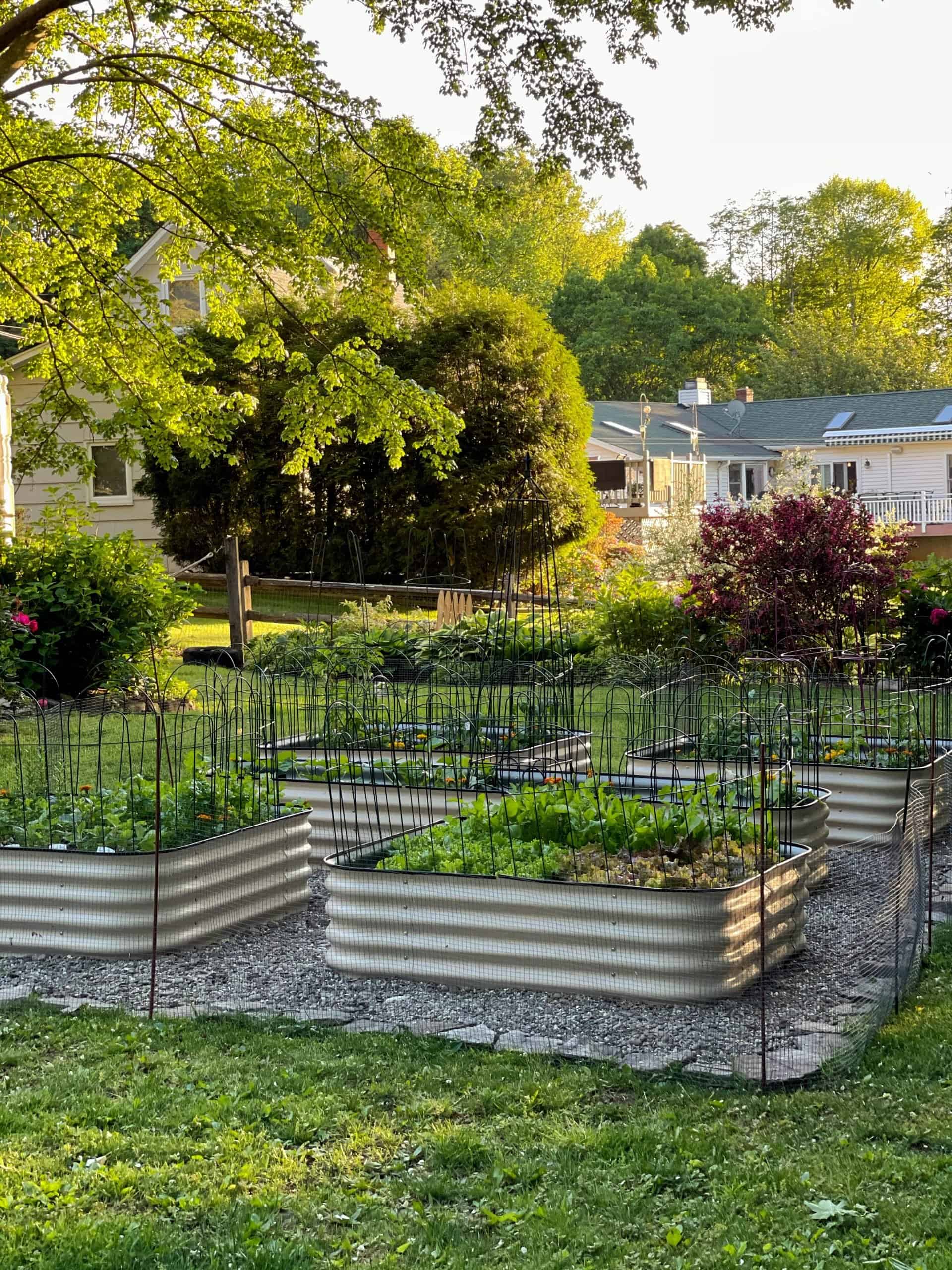
Beyond Repellents: Creative Ways to Scare Deer from Your Plants
There are devices you can use to scare deer out of your yard. Motion-activated sprinklers, lights, and radios have been known to help. The problem with using them is that they may only be a temporary solution to the problem. Deer can quickly figure out how to work around them.
I’ve tried using some of these before but don’t use them anymore. It is worth mentioning though in case you want to try it and it works for you.
Can Dogs Deter Deer? Barking Up the Right Tree for Garden Protection
Dogs are great deterrents for scaring off deer when they are outside. The problem with solely relying on dogs alone is that deer tend to do most of their damage during late hours when your dog may not be outside.

Want to Keep Deer Away From Plants? Walk Around Your Gardens Every Day
One of the best ways to keep deer from eating plants is to walk around your gardens every day or as often as possible to check on your plants. You can prevent major damage to plantings if you notice deer are starting to browse. When I see some damage, I grab the deer repellent spray and heavily douse high-risk plants.
A little extra vigilance can go a long way.

Deer-Proof Garden FAQs: Everything You Need to Know
Gardening with deer can feel like an endless battle. You’re not alone! Many gardeners face the frustrating challenge of protecting their plants from these hungry herbivores.
In this section, we’ve gathered the most frequently asked questions about deer deterrents and prevention methods, along with expert answers to help you win the war against deer and enjoy a flourishing garden.
What Naturally Keeps Deer Away From Plants?
Dealing with deer can be a challenging issue for many gardeners. Because deer are not fans of plants with a strong aroma or spikey foliage, there are lots of plants that naturally repel deer that will help keep your garden safe from damage.
To me, one of the best plants for keeping deer away is echinops. It looks really cool, makes a great cutting flower for bouquets, and has spikey bluish lavender flower heads with sharp foliage that deer tend to leave alone.
But another plant that deer tend to avoid is the Russian sage plant. Russian sage is a hardy perennial with silvery-gray leaves and spikes of lavender-blue flowers. It has a strong scent that deer find unappealing, and it’s also drought-tolerant and low-maintenance, making it an excellent choice for gardeners who want a beautiful, deer-resistant plant that requires little care.
Remember, no plant is entirely deer-proof, and hungry deer may eat anything when food is scarce. However, planting a mix of these deer-resistant plants can help deter deer from your garden and make it a more enjoyable place to spend time.

What is a Good Homemade Deer Repellent?
I don’t really recommend making them yourself as I have not found a recipe that works and stays on the plant better than what you can purchase commercially.
But if you want to try making some, you can try mixing hot sauce, garlic powder, and liquid dish soap with water to keep deer at bay. Keep in mind that this will wash off with the first rain, so you’ll need to re-apply as often as it rains.
If you prefer not to use a deer repellent, I’d focus more on planting herbs and flowers they don’t like or fencing in the garden with an 8′ garden fence.

What Smells Repel Deer?
Since deer have a heightened sense of smell, there are certain scents that help keep them away. Again, this is not a foolproof list, but can be helpful to keep deer from eating plants. And when you are trying to keep deer from eating your outdoor plants, anything is worth a shot!
- Wolf urine
- Lavender
- Marigold
- Rosemary
- Mint
- Garlic
- Sage
- Rotten eggs
- Onion
It’s worth noting that while these smells can be effective in deterring deer, they are not foolproof.
Hungry deer may still enter your garden if food is scarce. So it’s important to use a combination of methods, such as planting deer-resistant plants and using deterrents like fencing and repellents, to protect your garden from deer damage.

Will Irish Spring Keep Deer Away?
Some gardeners swear by hanging bars or using shavings of heavily scented soaps like Irish Spring in the garden. This has never worked for me. I garden in an area that sees herds of deer. This is not an effective method. Feel free to try it if you want, but I don’t recommend it.
Do Coffee Grinds Keep Deer Away?
While deer have a heightened sense of smell, some believe the bitter scent of coffee grinds can help keep deer away from plants. However, there is no scientific evidence to back up the claim that coffee grounds deter deer or keep them away from garden plants.

Outsmart Deer: Pre-Season Garden Protection Strategies
If deer are a problem in your area, familiarize yourself with the deer-resistant list during the winter so you know what you want before heading to the local garden nursery in spring. I also highly recommend purchasing deer repellent like this one well before the growing season so you are ready to go when the plants emerge from the ground.
When we procrastinate, we forget until it’s too late, so I would get what you need early and store it until spring.

Final Thoughts About How to Keep Deer Out of Your Garden
I hope this post inspires you to implement some strategies for maintaining a beautiful deer-resistant, happy, and healthy garden.
Don’t let deer dictate what you can grow in your garden. Take charge with these proven deer-proofing strategies and transform your outdoor space into a thriving, deer-free oasis. Start implementing these tips today, and soon you’ll be enjoying the fruits (and vegetables!) of your labor without the fear of unwanted visitors.
Remember, consistency is key. Deer are persistent, but with a well-rounded defense plan and a little patience, you can outsmart them and create a garden that both you and the local wildlife can appreciate from a distance.
No method is foolproof but there are things that we can do to protect our gardens. Every garden and gardener is different, so while one method might work for me, another method might work better for you in your landscape.
We learn how to garden through trial and error so play around with these tips and let me know how it works for you!
More Deer Proofing Information
For more information about deer proofing your garden, please see this article from Michigan State University.
Do you have a favorite deer-proofing method that wasn’t mentioned here? Share your tips and tricks in the comments below so we can chat more! I would love to learn from you too.
To drill down on more beginner gardening techniques and tips, please read these posts:
- Flower Gardening 101
- Growing a Cut Flower Garden for Beginners
- Container Garden Ideas for Beginners
- How to Start a Vegetable Garden
- Herb Gardening for Beginners
Thanks for stopping by the blog today!
Enjoy your day! xoxo


